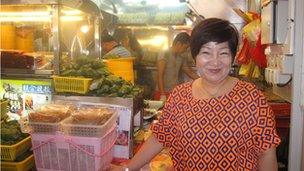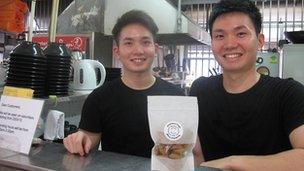Can Singapore's hawker food heritage survive?
- Published
Food hawker Abdus Salam abandoned his engineering career to take over his father's stall
Ask any Singaporean what the country's favourite local pastime is, and there's a good chance they will say "eating".
Singapore's food courts, known as hawker centres, are one of the country's most-loved institutions, providing meals and local delights for as little as S$3 ($2.4; £1.5).
Outside the most famous hawker stalls, you can find long queues of customers willing to wait for up to 30 minutes to be served - even though it's relatively inexpensive street food that they're waiting for.
But now there are fears that this aspect of Singapore's culinary heritage is on the wane.
The government has warned that there is a "real chance" that there will not be enough new people joining the industry to maintain Singapore's hawker centres.
"We can build many more hawker centres, but will we be able to get the hawkers?" Dr Vivian Balakrishnan, the minister responsible for Singapore's hawker centres, said recently, sparking concern amongst food-lovers.
Hawker centres are immensely popular - a 2010 government survey suggested that nearly half of Singaporeans eat at hawker centres six times a week or more.
Yet young people today are less willing to join a trade viewed as manual and relatively unglamorous.
"There are still negative stereotypes about hawkers, for example that they are less well-educated," says Hazel Tan, a Nanyang Technological University student who is behind Youth Hawkerprise, a campaign to encourage young people to join the hawker trade.
Singapore is an achievement-oriented society, and the goal of many parents is for their children to secure a white-collar job.
It's a view shared even by many of Singapore's successful hawkers.
'Hot and oily'
Seow Lai Hao, 58, runs Chai Ho Satay, a hawker stall selling grilled chicken and pork satay sticks. The stall has a loyal following, and long queues in front of the stall are a common sight.
Yet although she enjoys being her own boss, she also thinks that working in a hawker stall is not a job for young people.
"It's an old people's job," she says. "It's hot and oily and your hair smells of food when you go home."

Seow Lai Hao says it took her years of trial and error to make her satay stall a success
Young entrepreneurs joining the trade will also face challenges - such as building up a customer base.
"I've been making satay for 30 years," Ms Seow says. "When I started my stall it had no customers. It took a lot of trial and error to get the fire and charcoal [for grilling the satay] just right."
The home-grown nature of the hawker trade, and many famous recipes, is a source of pride for many Singaporeans.
Yet it may also make it difficult for young people to join the industry.
KF Seetoh, a street food consultant and founder of the World Streetfood Congress, says there is a lack of continuity. "A lot of hawkers are very successful, but many don't look at how to turn their business into an enterprise... the hawker trade isn't institutionalised."
Even if young people want to join the trade, it is difficult to find the right teachers to introduce them to the trade, as "master hawkers won't be willing to share their own recipes", he says.
'Culinary prejudice'
Singapore's Work Development Agency launched its first official hawker training programme earlier this year. Its progress will undoubtedly be watched closely.
For younger people who are already in the industry, their reasons for joining the trade can be varied.
Abdus Salam, 27, graduated with a degree in engineering and worked for two years in the semi-conductor industry. He decided to change careers and work in his father's food stall after he saw that his father found it difficult working alone.
"My parents' dream was for me to be in a 'reputable' position, which I achieved by getting my degree," he said. "But as the eldest son in my family, I also felt a duty to help my parents."
He now hopes to franchise the business, and preserve his family recipe for Indian rojak, a mixture of dough fritters, seafood and vegetables.
Meanwhile, brothers Cai Wei Li (29) and Cai Wei Shing (26) say they first gained a passion for cooking when trying to lose weight.
"We started making our own food because it's much healthier to cook your own food, and then we developed a passion for cooking," says Cai Wei Li.
The brothers now run a stall selling Japanese ramen noodles and cookies - an unconventional combination that older-generation hawkers are less likely to consider.
Despite the recent drive to encourage more young people to join the trade, it is still associated with older generations.
"When [potential customers] see that you're young, they assume that you're less experienced and don't know how to cook," Cai Wei Sheng says.

Brothers Cai Wei Shing (left) and Cai Wei Li say it is challenging being a young hawker
Ultimately, the challenges facing the sector may boil down to a contradiction in Singapore's attitudes to hawker food.
"We all love hawker food, but our aspiring chefs are being taught about westernised food and ways of cooking," says Leslie Tay, a prominent Singaporean food blogger and author of several books on Singaporean food.
"We have this culinary prejudice where we are willing to pay S$20 for a pasta carbonara but will complain when the price of a plate of Hokkien Mee [fried noodles] increases from S$3 to S$3.50. So we do need to place our own Singaporean heritage and hawker culture on a higher level."
In other words, if Singaporeans want to continue eating the street food they love in the future, they may need to put their money where their mouth is - either by paying more, or changing their perceptions of the hawker industry.
- Published17 May 2013